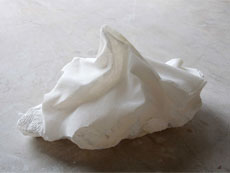

English translation below.
16 October 2010
NRC Handelsblad: Galerie Amsterdam
        Impression of the exhibition at Reuten Gallery in October 2010 |

Lynne Leegte, Hands (2008)
Stenen zakdoek die je zo in de was zou doen
Ze is geen kunstenaar van het grote gebaar, die uitspraken doet over de stand van zaken in de wereld, reusachtige installaties bouwt en meters linnen en liters verf nodig heeft. De in Amsterdam wonende, Britse kunstenaar Lynne Leegte (1965) houdt het bescheiden.
Een neutrale ruimte, zijzelf als model daarin, een camera bij de hand, een paar spiegels, kanten zakdoekjes. Dat zijn de typische, vrouwelijke attributen waarmee Leegte foto's maakt. Daarnaast beeldhouwt ze: kleine surrealistische objecten van brons, was of doorzichtig albast. Alles met een uitstraling die even doodstil is als wonderschoon.
Bij Reuten Galerie in Amsterdam heeft de kunstenaar het souterrain veranderd in een totaalinstallatie. Op een tafel liggen Worn Mirrors, met gaten op de plaats van het glas. Op een stoel ligt een Discarded Handkerchief van albast – je zou hem haast oppakken en in de was doen.
Daaromheen heeft de kunstenaar foto's opgehangen van zichzelf. Je ziet een taille, twee handen, een hand die een zakdoekje vasthoudt, de plooien van een rok, een gezicht verscholen achter handspiegels of weggedraaid van de kijker. Die foto's hangen op oog-, knie-, hand- en taille-hoogte, afhankelijk van het lichaamsdeel dat gefotografeerd is. Als kijker word je daardoor heel direct de voorstelling in getrokken. Identificatie is onvermijdelijk als de hand die een zakdoek vasthoudt ook jouw hand zou kunnen zijn.
Maar opmerkelijker is het spel van licht en donker op de foto's. Leegte maakt alles in haar eentje, met behulp van een op afstand te bedienen camera, en geeft daarom van tevoren ruim aandacht aan licht en de werking daarvan.
Plooien van een jurk fotografeert zij zo dat ze eruitzien als rulle aarde in een pas geploegde akker.
Schaduwen lijken gebeeldhouwd, witte huid van parelmoer. In de foto's wordt duidelijk waar Leegte haar inspiratie haalt: bij de grote 17de-eeuwse meesters van het licht, Johannes Vermeer en Pieter Saenredam. Wat zij deden met een kerkvloer of een kan melk doet Leegte met een lap stof en slechts een enkel lichaamsdeel.
Lucette ter Borg
---
An Alabaster Handkerchief poised ready for the Washing Machine.
She is not an artist with great gestures giving opinions on the state of world affairs, or one who builds gigantic installations or incorporates meters of linen and litres of paint. The British artist Lynne Leegte (1965) resident in Amsterdam works in a modest way.
A neutral space, herself as model, a camera at hand, a few mirrors, lace handkerchiefs these are the typical feminine attributes with which Leegte makes her photos. In addition she sculpts small surrealistic objects in bronze, wax or translucent alabaster. Everything with a radiation that is serenely silent as well as extraordinary beautiful.
The artist has transformed the Reuten gallery in the basement into a complete installation. "Worn Mirrors" lie on a table, their glass worn into holes. On a chair lies an alabaster Discarded Handkerchief so real you feel you could just pick it up and toss it into the washing machine.
The artist has placed photos of herself on the surrounding walls. One sees a waist-line, two hands, a hand holding a handkerchief, the folds of a skirt, a face hidden behind hand mirrors or turning away from the observer. The photos hang on eye, knee and waist level their position determined by the part of the body that has been photographed. As a result the observer is directly involved with the artwork. Identification is inevitable as if the hand holding the handkerchief before you could also be your own.
But the way light and darkness are used in the photos is remarkable. Leegte makes everything herself with the help of a camera operated by remote control and gives much preparatory thought to the use of light and its effects. She photographs folds in a dress so that they resemble furrows of earth in a newly ploughed field. Shadows resemble the sculpted white surface of mother-of-pearl.
The photos clearly show where Leegte draws her inspiration: from the great 17th century masters of the light, Johannes Vermeer and Pieter Saenredam. What they achieved with a floor of a church or a jug of milk is done by Leegte with a piece of cloth and just a part of the body.